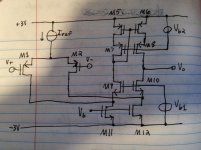I have the input stage attached. Since it's a low voltage amplifier I'm using mosfets. I've got a p channel differential input pair (M1 and M2), P channel current mirror (M5-M8), n channel folded cascodes (M9,M10), current sources (M11,M12). I will have the current sources (M11,M12) the same value as Iref. The Vout will go to a Voltage Amplification Stage. Would it be beneficial to use the BJTs as the current mirror instead of the transistors M5-M8 in this case?
Attachments
That's an integrated circuit CMOS amplifier which requires relatively fancy biasing to get "Iref" (the tail current of the input diffpair) and "Vb" (the bias for the reflector currents of the folded cascode) to play well over process, voltage, temperature, and common mode input voltage. I don't think it would be wise AT ALL, to ask your boss to select, qualify, and pay for a rather more esoteric BiCMOS fabrication process, just so you can achieve a marginally better current mirror.
Take a look at what the competition can do / has done with plain ordinary CMOS. They're working with 2.7V to 5.0V of total supply voltage (you've got 6.0V). Yet they get excellent input offset voltage, excellent low power, excellent high bandwidth, and excellent slew rate. Why can't you? The answer is: you can!
Take a look at what the competition can do / has done with plain ordinary CMOS. They're working with 2.7V to 5.0V of total supply voltage (you've got 6.0V). Yet they get excellent input offset voltage, excellent low power, excellent high bandwidth, and excellent slew rate. Why can't you? The answer is: you can!
- Status
- Not open for further replies.
